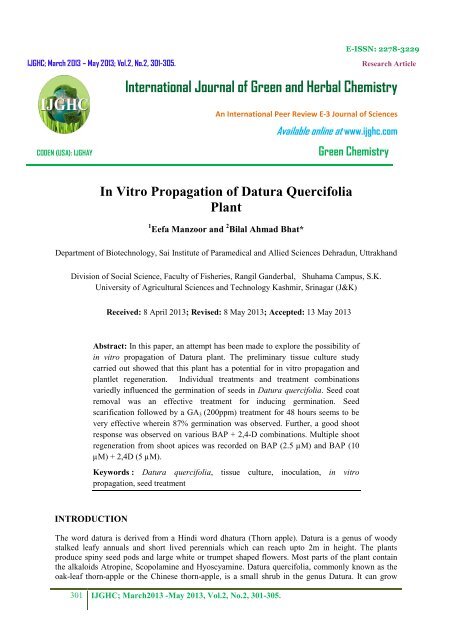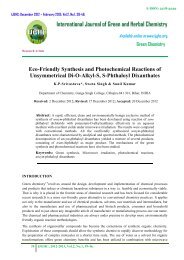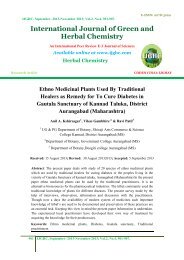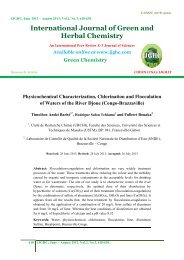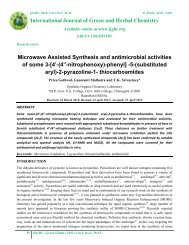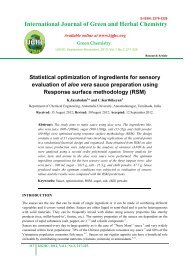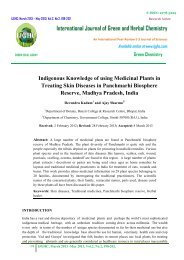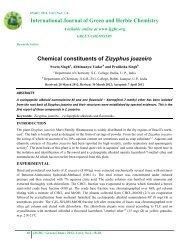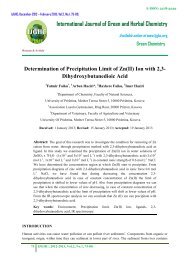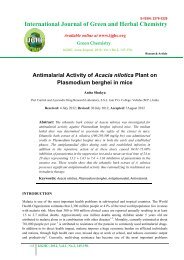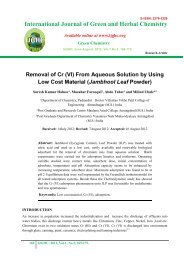In Vitro Propagation of Datura Quercifolia Plant - IJGHC
In Vitro Propagation of Datura Quercifolia Plant - IJGHC
In Vitro Propagation of Datura Quercifolia Plant - IJGHC
You also want an ePaper? Increase the reach of your titles
YUMPU automatically turns print PDFs into web optimized ePapers that Google loves.
E-ISSN: 2278-3229<strong>IJGHC</strong>; March 2013 – May 2013; Vol.2, No.2, 301-305.E-ISSN: 2278-3229Research Article<strong>In</strong>ternational Journal <strong>of</strong> Green and Herbal ChemistryCODEN (USA): IJGHAYAn <strong>In</strong>ternational Peer Review E-3 Journal <strong>of</strong> SciencesAvailable online at www.ijghc.comGreen Chemistry<strong>In</strong> <strong>Vitro</strong> <strong>Propagation</strong> <strong>of</strong> <strong>Datura</strong> <strong>Quercifolia</strong><strong>Plant</strong>1 Eefa Manzoor and 2 Bilal Ahmad Bhat*Department <strong>of</strong> Biotechnology, Sai <strong>In</strong>stitute <strong>of</strong> Paramedical and Allied Sciences Dehradun, UttrakhandDivision <strong>of</strong> Social Science, Faculty <strong>of</strong> Fisheries, Rangil Ganderbal, Shuhama Campus, S.K.University <strong>of</strong> Agricultural Sciences and Technology Kashmir, Srinagar (J&K)Received: 8 April 2013; Revised: 8 May 2013; Accepted: 13 May 2013Abstract: <strong>In</strong> this paper, an attempt has been made to explore the possibility <strong>of</strong>in vitro propagation <strong>of</strong> <strong>Datura</strong> plant. The preliminary tissue culture studycarried out showed that this plant has a potential for in vitro propagation andplantlet regeneration. <strong>In</strong>dividual treatments and treatment combinationsvariedly influenced the germination <strong>of</strong> seeds in <strong>Datura</strong> quercifolia. Seed coatremoval was an effective treatment for inducing germination. Seedscarification followed by a GA 3 (200ppm) treatment for 48 hours seems to bevery effective wherein 87% germination was observed. Further, a good shootresponse was observed on various BAP + 2,4-D combinations. Multiple shootregeneration from shoot apices was recorded on BAP (2.5 µM) and BAP (10µM) + 2,4D (5 µM).Keywords : <strong>Datura</strong> quercifolia, tissue culture, inoculation, in vitropropagation, seed treatmentINTRODUCTIONThe word datura is derived from a Hindi word dhatura (Thorn apple). <strong>Datura</strong> is a genus <strong>of</strong> woodystalked leafy annuals and short lived perennials which can reach upto 2m in height. The plantsproduce spiny seed pods and large white or trumpet shaped flowers. Most parts <strong>of</strong> the plant containthe alkaloids Atropine, Scopolamine and Hyoscyamine. <strong>Datura</strong> quercifolia, commonly known as theoak-leaf thorn-apple or the Chinese thorn-apple, is a small shrub in the genus <strong>Datura</strong>. It can grow301 <strong>IJGHC</strong>; March2013 -May 2013, Vol.2, No.2, 301-305.
<strong>In</strong><strong>Vitro</strong>...Eefa Manzoor and Bilal Ahmad Bhatwithin dry or moist soils and requires large amount <strong>of</strong> sunlight to grow. The plant produce greencolored fruit with long sharp spikes or spines. The flowers are cream white to purple in color. Theleaves resmeble oak leaves, hence the etymology <strong>of</strong> the species epithet, "quercifolia". It is used as adecorative ormental plant. <strong>Datura</strong> quercifolia is a member <strong>of</strong> the nightshade family and is also calledjimsonweed. Relationship between alkaloid production and growth measured as bio mass increaseand cellular division frequency in <strong>Datura</strong> Stramonium in vitro root cultures was observed by 1 Baize etal. (1998). Improvement in seed germination percentage and seedling growth in <strong>Datura</strong> innoxia bypresowing seed treatment with vitamin B1, B6, B complex and C was recorded by Rajagopal et al 2 .(2001). Vitamins improved seed germination percentage and among concentrations 500 ppm provedoptimum for most parameters. An efficient protocol for in vitro production <strong>of</strong> <strong>Datura</strong> metel plantletfrom stem and leaf explants excised from in vivo source and cultured 3 on MS 1962 mediumsupplemented with NAA, IBA, 2.4-D, BAP and GA3 either singly or in combination was establishedby Sood and Guilleti 4 . Effect <strong>of</strong> light had a cardinal role that influenced growth and multiplication <strong>of</strong>plantlets in vitro. Continuous illumination <strong>of</strong> the cultures promoted better and efficient growth. Thepresent study was carried out with following objectives in view (i) Breaking down the dormancy <strong>of</strong>seeds <strong>of</strong> <strong>Datura</strong> quercifolia: various methods and treatments involved (ii) <strong>In</strong> vitro propagation <strong>of</strong><strong>Datura</strong> quercifolia.MATERIALS AND METHODSeeds <strong>of</strong> <strong>Datura</strong> quercifolia were collected from field gene bank <strong>of</strong> IIIM, Srinagar. The seeds weredivided into groups <strong>of</strong> 50 seeds each. The seeds were washed with 0.1% mercuric chloride for 5-7minutes and then with 70% alcohol for 1 minute. Then seeds were thoroughly rinsed with doubledistilled water. The seeds were then subjected to various treatments and placed on a moist silter paperin a petri-plate <strong>of</strong> 4 inches diameter. The various treatments given were:a. Chilling: Seeds were subjected to chilling (at 4 0 C) for 48 h and 72 using L.G refrigerator.b. Gibberellic acid: GA 3 treatment <strong>of</strong> 200 ppm prepared by dissolving 200 mg <strong>of</strong> GA 3 in 1000ml <strong>of</strong> distilled water. The seeds were kept in each <strong>of</strong> the solutions for about 24 hours followedby a wash in autoclaved double distilled water.c. Sulphuric acid (H 2 SO 4 ) treatment: Seeds were kept in a muslin cloth and then dipped inconcentrated H 2 SO 4 for 3 minutes followed by a wash in autoclaved double distilled water.Sulphuric acid Merck used was 99.9% pure.d. Sand paper scarification: Sand paper <strong>of</strong> “size 100” was used. The seeds were kept betweentwo sheets <strong>of</strong> sand paper and rubbed 8 times.e. For each treatment two replicates were used. A set <strong>of</strong> control was kept to comparegermination efficiency. MS medium was used for plant tissue cultures for morphogenesis andplant regeneration. The sterilized explants were inoculated in sterile MS medium containingdifferent concentrations <strong>of</strong> harrmones under aseptic conditions in a Laminar Flower andincubated under 16 h light period at 25 0 C.RESULTS AND DISCUSSIONSeeds for each treatment were kept in the lab conditions (average temperature 15-20 0 C). Replicateswere monitored in ordinary light and complete darkness. The germination <strong>of</strong> seeds was monitored andthe details recorded. <strong>Datura</strong> seed can show high or low germination rates and seedling emergence canbe quite irregular. Species such as D. stramonium (jimsonweed) tend to sprout readily, while otherslike <strong>Datura</strong> quercifolia may not germinate for 9 months to a year. Various treatments were given to aset <strong>of</strong> unchilled seeds. Un-chilled seeds kept in ordinary light without any treatment didn’t show anygermination. Seeds were scarified and also given GA 3 treatment (Table 1).302 <strong>IJGHC</strong>; March2013 -May 2013, Vol.2, No.2, 301-305.
<strong>In</strong><strong>Vitro</strong>...Eefa Manzoor and Bilal Ahmad BhatTable 1: <strong>In</strong>-vitro seed germination studies in <strong>Datura</strong> quercifoliaTreatmentNo. <strong>of</strong> daystaken for firstseed togerminateNo. <strong>of</strong> daystaken for lastseed togerminateGermination %L D L D L DControl 0 0 0 0 0 0Sand paperScarificationAcid Wash(3 min)GA 3 200ppm2 23 30 23 25 62 2 8 11 50 332 2 20 10 87 50L: Light, D: DarknessMaximum germination (87%) was recorded in seeds treated with GA 3 (200ppm) for 48 h andinoculated on simple distilled water kept under light. Seeds whose seed coat was scarified withsand paper and kept in complete darkness showed least germination <strong>of</strong> 6%. A set <strong>of</strong> seeds werescarified and chilled for (48-72h). Maximum germination in chilled seeds was observed in 48 hchilling (60%) kept in light (Table 1).Shoot tips excised from in vitro raised seedlings were used as primary explants and inoculated onMS medium augmented with different growth regulators. Various types <strong>of</strong> morphogeneticresponses recorded are depicted in (Table 2).Table- 2: Morphogenetic response <strong>of</strong> shoot tips <strong>of</strong> <strong>Datura</strong> quercifolia to variousPhytohormones.Medium* Nature <strong>of</strong> Response** Response %MS basal medium No Response 0%MS (x1/2) + BAP(2.5 µM) <strong>In</strong>itiation <strong>of</strong> shoots 30%MS + BAP (5 µM) No Response 0%MS +BAP (5 µM) + NAA (5 µM)<strong>In</strong>itiation <strong>of</strong> shoot multiplicationfollowed by stunted growth40%MS + 2,4-D (5 µM) + BAP (10 µM) Shoot multiplication and elongation 70%*10 replicates per treatment, **Data scored after 5 weeks <strong>of</strong> culture period303 <strong>IJGHC</strong>; March2013 -May 2013, Vol.2, No.2, 301-305.
<strong>In</strong><strong>Vitro</strong>...Eefa Manzoor and Bilal Ahmad BhatShoot tips cultured on MS (1/2x) + BAP (2.5 µM) showed initiation <strong>of</strong> shoots followed by stuntedgrowth pattern. <strong>In</strong>itiation <strong>of</strong> multiple shoots also took place on MS (1/2x) + BAP (5 µM) +NAA (5µM) which also was followed by stunted growth pattern. However a combination <strong>of</strong> 2,4-D (5 µM) +BAP (10 µM) resulted in multiple shoot formation and its subsequent elongation.The relevance and significance <strong>of</strong> different seed treatments for breaking dormancy and improvingseed germination is well known 5 . Treatments such as soaking before sowing, seed coat puncturing,scarification, acid wash, chilling, GA 7 .During the present investigation <strong>of</strong> <strong>Datura</strong> quercifolia it is observed that unchilled seeds subjected toscarification showed 50% germination and survival in light. <strong>In</strong> complete darkness 33% seeds recordedgermination. Beigh et al. 6 obtained 50% germination in scarified seeds <strong>of</strong> Podophyllum hexandrumnot subjected to any chilling. Similar results were also obtained by Andrabi 7 in scarified seeds <strong>of</strong>Atropa acuminata kept in ordinary light. Further, unchilled seeds <strong>of</strong> <strong>Datura</strong> quercifolia subjected toacid wash showed 50% germination. <strong>In</strong> similar studies carried out by Bisht and Kediyal 8 on Atropabelladona seeds treated with sulphuric acid (75%) followed by sodium hydroxide (30%) recordedseed germination.Unchilled seeds <strong>of</strong> <strong>Datura</strong> quercifolia were scarified followed by 48 h dip in GA 3 (200 ppm). Bestresults (87%) were recorded in seeds treated with GA 3 (200ppm) in ordinary light .50% germinationwas recorded in seeds kept in complete darkness.Similar results were obtained in Atropa belladonna seed germination studies carried out byAndrabi 7 . The effect <strong>of</strong> pre-chilling followed by seed coat scarification showed best results (60%germination) in 48h chilled seeds in light. This was followed by 20% germination in seeds chilled for48h in complete darkness. 72h pre-chilling followed by seed coat scarification resulted in 16% seedgermination in light and 13% in complete darkness. It is observed that scarification together withother treatments do selectively influence seed germination. <strong>In</strong> present study maximum shoot numberwas obtained on MS enriched with 2,4-D (5 µM) + BAP (10 µM) using shoot tips as explants. Theseresults reveal that the behaviour <strong>of</strong> regeneration phenomenon shown by the plant is more or lesssimilar to other medicinal plants like Artemisia pallens 9 and Dioscorea floribunda 10 .CONCLUSIONOur study, conducted to explore the possibility <strong>of</strong> in vitro propagation <strong>of</strong> <strong>Datura</strong> quercifolia, amedicinally important plant. The preliminary tissue culture study carried out showed that this planthas a potential for in vitro propagation and plantlet regeneration. <strong>In</strong>dividual treatments and treatmentcombinations variedly influenced the germination <strong>of</strong> seeds in <strong>Datura</strong> quercifolia. Seed coat removalwas an effective treatment for inducing germination. Seed scarification followed by a GA 3 (200ppm)treatment for 48 hours seems to be very effective where in rapid 87% germination was observed. <strong>In</strong>our study good shoot response was observed on various BAP + 2, 4-D combinations. Multiple shootregeneration from shoot apices was recorded on BAP (2.5 µM) and BAP (10 µM) + 2,4D (5 µM).Similar reports <strong>of</strong> multiple shoot regeneration in shoot tip cultures <strong>of</strong> Lavandula <strong>of</strong>ficinalis on variousBAP concentrations and combinations has been recorded by Tyub et al (2004). <strong>In</strong> conclusion presentinvestigation forms an important preliminary step for breaking seed dormancy and inducing rapidseed germination in <strong>Datura</strong> quercifolia and its subsequent micro propagation. Extension <strong>of</strong> thesestudies will prove highly beneficial for future strategies in tissue culture studies for propagation <strong>of</strong> thisplant.304 <strong>IJGHC</strong>; March2013 -May 2013, Vol.2, No.2, 301-305.
<strong>In</strong><strong>Vitro</strong>...Eefa Manzoor and Bilal Ahmad BhatACKNOWLEDGMENTSThe authors are highly thankful to the referee(s) and the editor <strong>of</strong> the Journal for their valuablesuggestions, which helped in improving the quality <strong>of</strong> our research paper.REFERENCES1. A.M.Baize,A. Quiroz,J.A. Malnado-Mendoza and Loyola-Vargas, Growth patternsand alkaloid accumulation in hairy root and untransformed root cultures <strong>of</strong> <strong>Datura</strong>stramonium. <strong>Plant</strong> cell, Tissue and Organ Culture, 1998, 54(2): 123-130.2. R.Rajagopal, S.H. Afaq, Afridi and R.H.Mohammed, Germination and Growth <strong>of</strong><strong>Datura</strong> innoxia Mill, (II): Effect <strong>of</strong> pre-sowing seed treatment with 4 vitamins ongermination and seedling growth in pot culture. Hamdard Medicus, 2001, 44 (1): 99-108.3. T. Murashige and F. Skoog, A revised medium for rapid growth and bioassays withtobacco tissuecultures. Physiol. <strong>Plant</strong>arum, 1962,15 : 473–497.4. Sood N. P and Guilleti, Efficient protocol for in vitro differentiation and plantletformation from callus culture <strong>of</strong> <strong>Datura</strong> metel. J Sci Pharmacy, 2002, 3 (2): 66-67.5. Thomas, Seed treatments and technique to improve germination. Scientia hortic1981, 32:47-516. S.Y.Beigh, M. Iqbal and I.A. Nawchoo, <strong>In</strong> vitro seed germination studies on Himalayas Podophyllum hexandrum Royle, an endangered medicinal plant <strong>of</strong> Northwest,2002, 22(3):132-134.7. F.Andrabi, Studies on seed biology for developing conservation and strategies forAtropa acuminata, a threatened medicinal plant <strong>of</strong> Kashmir Himalayas,2002,11(2):2-3.8. Bisht and Kediyal, Effect <strong>of</strong> chemical treatments on germination and survival <strong>of</strong> theseedlings in Atropa belladomna Linn. <strong>In</strong>dian J. Forestry, 1995, 11(3): 208-210.9. B.D.Benjamin,A.T. Sipahimalni, and M.R.Heble, Tissue culture <strong>of</strong> Artemesiapallens. <strong>Plant</strong> cell tissue and organ culture,1990, 21:159-164.10. J.Sengupta,G.C. Mitra, Organogenesis and tuberization in cultures <strong>of</strong> Dioscoreafloribinda. plant cell tissue and organ culture, 1984,3(4):325-332.Corresponding author: Bilal Ahmad Bhat; Division <strong>of</strong> Social Science, Faculty <strong>of</strong> Fisheries, Rangil Ganderbal,Shuhama Campus, S.K. University <strong>of</strong> Agricultural Sciences and Technology Kashmir, Srinagar (J&K)305 <strong>IJGHC</strong>; March2013 -May 2013, Vol.2, No.2, 301-305.


